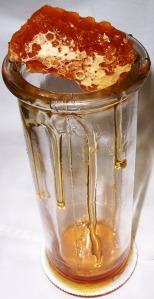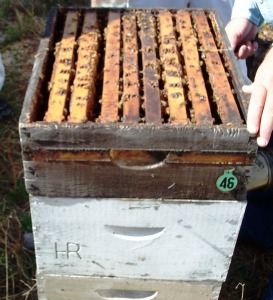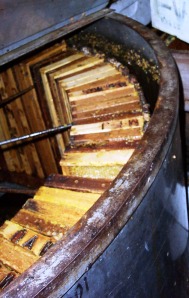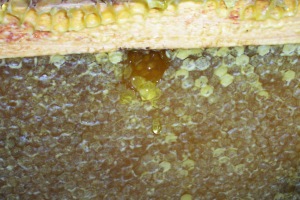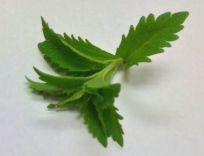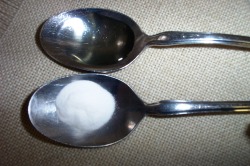Of Bees & Honey
Honey is made from flower nectar; the type of honey depends on the type of nectar source. It consists of fructose and glucose. Nectar is 75% water, with many minerals in it.
Apiculture is the science of beekeeping. It dates back to 700 BC. In mythological times, it was a symbol of life and wealth, attributing to medicinal properties. Honey was used as a purifier, antiseptic, skin toner, a sedative, a digestive aid, to reduce fevers, and stimulate the appetite. The oldest know record of honey harvesting is a 7000 BC rock painting is Spain.
Honey was the most important sweetener of the Middle Ages. It was used as a condiment. In Greek mythology, it played an important role. Native Americans used only honey as a sweetener until the import of sugar cane. They also used it as a preservative, a cooking liquid, and for its medicinal properties.
Since the science of beekeeping is known as apiculture, the hive structure is known as apiary. Bees use honey as a source of nourishment. The worker bees gather nectar from flowers. The nectar is projected in to a honey sac, which is in the bee’s esophagus, where it mixes with the bee’s saliva. Honey is created by the action of enzymes in saliva and gastric juices. This produces glucose and fructose. This honey is then deposited in the cells of the bee hive. The internal temperature of the hive is 96F. As the honey cools, the flavor may vary.
Man made bee hives are boxes which contain frames. In the frames, the bees build beeswax cells. When the frames are removed, the bees are brushed off, and then the beeswax is shaved off with a hot knife. This is known as capping. The frames are then placed in an extractor, or slotted centrifuge that spins the honey.
It takes almost 5 gallons of nectar to produce 1 gallon of honey. One quart of nectar can range from 20,000 to 100,000 trips for bees. In a colony, there are approximately 30,000 to 60,000 bees. One colony of bees can produce two pounds of honey a day.
Honey comes in a few different forms. Whipped honey is finely crystallized honey that it is creamy and spreadable. Comb honey contains liquid still in the chewy comb. Chunk style honey is honey that contains little pieces of the honeycomb. Liquid honey is extracted from the comb and pasteurized to prevent crystallization. Cream or spun honey is processed into a crystallized stated so it is firm at room temperature, and spreadable. All types of honey should be stored in a tightly sealed container. “Pure” honey has not been adulterated with something else, like corn syrup.
Honey is collected twice a year. The first honey produces the finest honey. It is collected in the early summer months, usually May or June. The second harvest is at the end of summer.
There is over 300 varieties of honey collected in the United States; more than 3000 worldwide. There are over 181 substances identified as influencing the taste of honey. Most hive honey is a multi flower honey, known as floral or country honey. Beekeepers will either restrict bees’ activity by allowing them to go to one bloom, then removing the hive or by placing the hive near a particular type of bloom for a while, then removing it.
The color of honey ranges from white, brown, red, blond, yellow, and black. Usually the darker the color, the stronger the flavor.
Honey is great for cooking and baking. Honey is hygroscopic, meaning is absorbs and retains moisture. Breads, cakes, and other baked goods stay moister longer. If using honey to replace sugar, use 1 part honey to every 1-1/4 parts sugar, (or 80% of the amount sugar). Since honey is in the liquid state, decrease the main liquid by 1/4 cup. Honey is heavier than sugar, so increase the amount of baking soda (or add to the recipe) by 1/2 teaspoon). You also need to decrease the oven temperature by 25º. Sometimes heating honey may alter its taste. It also may contain clostrium botulism, which causes botulism. Honey should not be fed to babies less than one year of age.
The legend of the honeymoon is from Eastern Cultures. Honey is poured into newlyweds hands. They must lick it all off. It is a sign that they will take all of their food together. It also symbolizes the husband will not lift hand to wife except to caress her, and none but loving words will come from wife’s lips. In Greco Latin Cultures, golden yellow is the most sacred color.
Seared Sea Scallops with Stewed Fennel, Tomatoes, and Clover Honey
Chef Jennifer Denlinger, Chef Brandy Williamson LCBO c/o 2005
“Show Me the Honey” Recipe Contest Winner
Serves 4
Olive oil
Ground Black Pepper
Kosher Salt
1/8 tsp ground fennel seed
12 ea U10 sea scallops
8 oz fennel bulb
1 yellow onion, diced small
2 # Roma Tomatoes, peeled, seeded, and chopped rough
1/3 cup plus 2 tbsp clover honey
Micro Greens
8 croutons, sliced from a loaf of French bread, then toasted in the oven with olive oil
- Heat a medium sauce pan over medium heat. Add 1 tbsp olive oil. Add the onions and sauté until translucent.
- Add the fennel, tomatoes, and 1/3 cup honey. Cook over medium- high heat.
- Stew the vegetables for about 20 minutes. The fennel should be tender, and the tomatoes should have lost their shape. Season to taste with salt and pepper.
- Place the sea scallops in a bowl. Season well with salt and pepper and add the ground fennel seeds. Add about 3 tbsp olive oil and toss well to completely coat.
- Heat a medium heavy bottomed sauté pan over medium high heat. Place each scallop in the pan, so it sits flat. Make sure the scallops aren’t touching each other.
- When the scallops are crispy and brown on one side, flip over and sear on the other side.
- The scallops should be cooked to the equivalent to medium or medium well.
- To serve, spoon a large tablespoon of stew in the center of a warm plate.
- Place 3 seared sea scallops around the stew. Drizzle each plate with approximately ½ tbsp honey. Garnish with micro greens. Serve with 2 slices of crouton.
Originally Published 8-18-11
© 2011 Chef Jennifer M. Denlinger All rights reserved
Please contact me for permission to use or reference this work.
Please contact me if you wish to receive “Food For Thought” in your mailbox.
